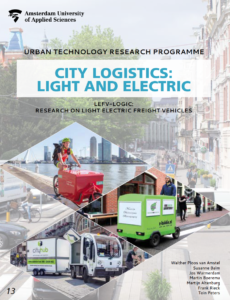A new publication presents the results of the LEFV-LOGIC project: a two-year research into the use of light electric freight vehicles for city logistics. In this project Amsterdam University of Applied Sciences, Rotterdam University of Applied Sciences and HAN University of Applied Sciences, together with logistics service providers, shippers, vehicle suppliers, network organizations, knowledge institutions, and municipalities have developed new knowledge about logistics concepts and business models for the deployment of LEFVs.
A LEFV is a bike, moped or compact vehicle with electric assistance or drive mechanism, designed for the distribution of goods in public space with limited speed. LEFVs are quiet, agile and emission-free and take up less space than conventional vans and trucks. LEFV-LOGIC project partners share an ambition to contribute to regional, national and European objectives to organize urban freight transport in a quieter, cleaner and more efficient way.
LEFV-LOGIC project
LEFV-LOGIC started in 2016 from a question of logistics service from small and medium-sized enterprises (SMEs) which want to use LEFVs but did not know how to do so profitably. The logistics processes in the chain are particularly suited to the use of vans and trucks. In addition, it was not sufficiently clear which city logistical flows and market propositions LEFVs are suitable for, which technical requirements should be met, and which policy measures influence the use of LEFVs.
LEFV-LOGIC project partners worked together on:
- Exploring the potential of LEFVs for city logistics flows
- The design of new logistics concepts for LEFVs
- Technical designs of and modifications to LEFVs
- Policy around LEFVs
- Research on scalable business models involving LEFVs
- Practical experiments with new LEFV concepts.
Results
The main conclusions are:
LEFVs could replace 10-15% of delivery vehicle movements
LEFVs are used by a variety of professionals, from briefcase-carrying self-employed entrepreneurs to logistics service providers carrying roll container trolleys. The industry sectors with the most potential in city logistics are food, construction, services, non-food retail and post and parcel delivery. It is estimated that 10 to 15 percent of the trips with a delivery vehicle in cities are suitable for cost-effective deployment of LEFVs.
LEFVs demand a different logistics concept
Transportation costs are determined largely by personnel costs. LEFVs can be beneficially deployed if the delivery can be performed faster than with a conventional vehicle. This occurs in areas where vehicle speed or access is limited, where the delivery addresses are close together or where finding a good parking place is important. To utilise this time advantage, a logistics concept is required either solely with inner-city rides or with transfer points in the city where the extra transshipment costs incurred at a hub (personnel, equipment, location) will be recouped in the chain. This requires planning and control systems that match the load capacity and routes of LEFVs, suitable load carriers, and suitable staff.
The technology must be developed further
LEFV vehicle technology is still at an early stage and LEFVs are not yet mass produced. There is currently a very limited offering in cooling capabilities and for standardized load carriers (containerization). In the case of small electric distribution vehicles, the electric delivery van is increasingly competitive in cost, speed, load capacity, and deployability (for example, by accessing highways).
With limited use of LEFVs entrepreneurs experience no barriers to charging the vehicles. As LEFVs use far less energy than e-vans, the load on the grid is relatively limited. When electric fleets are expanded, smart charging offers a solution to balancing out peaks and troughs in energy demand.
The policy is still unclear but can stimulate the adoption of LEFVs
Urban infrastructure and traffic rules are not yet prepared for an increase in the number of LEFVs. There is uncertainty over which part of the streetscape LEFVs will be allowed to use to drive, load and unload; and furthermore there is a shortage of parking facilities. Further speed limits on the road, the construction of bicycle streets and installation of loading and unloading spaces for LEFVs offer opportunities for better integration of LEFVs in traffic. Purchase subsidies, experiments with LEFVs and realisation of policy objectives (such as emission-free or car-free cities) help to bring about a behavioural change among businesses.
The growth of LEFV use requires a scalable business model
LEFVs have been successfully deployed in market segments where low weights and volumes are transported, in which operational excellence is key, or where the use of LEFVs contributes to a distinctive social and innovative value proposition. The scalability of a business model involving LEFVs is limited in cases where customers need to be mobilised in the first instance to use the solution; where customers must adapt their processes or systems; or where scaling up depends on a major expansion of investment in vehicles, whilst capital is lacking. Recipients of goods or services themselves feel no urgency to pursue supply by LEFV by vendors and carriers, but do respond positively if it happens.
A LEFV is a solution which can be used in conjunction with other solutions. A combination of vehicles ensures flexibility and assurance that customer demand can be satisfied. The deployment of a LEFV can ensure that fewer businesses need to use a conventional delivery vehicle.
You can find the full report here.


[…] Voor stadslogistiek is die stip op de horizon best spannend. Elektrische bestelauto’s komen nu mondjesmaat in de markt en ervaringen met onder meer Streetscooter, Goupil, Renault en Nissan zijn positief. In kosten van dagelijks gebruik doen ze niet onder voor diesel bestelauto’s. Die elektrische bestelauto’s gaan er vast en zeker wel komen in de komende 5 tot 10 jaar. Dat geldt ook voor het aanbod van lichte elektrische voertuigen en vrachtfietsen; ‘bigger is not always better’. […]